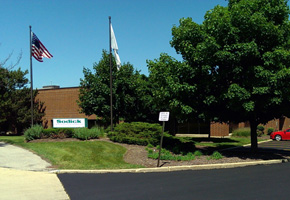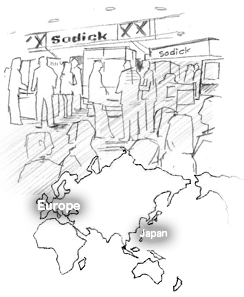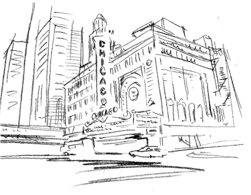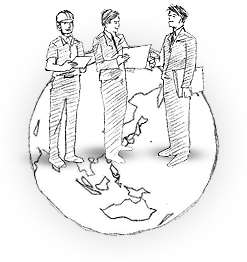History of Sodick
Part 2: Rapid Growth Phase to Overseas Expansion Phase
Sales Growth in Europe and North America

Sodick Deutschland GmbH (Germany)
Sodi-tech EDM (UK)

Sodick, inc.(U.S.)
Sodick has been attempting to establish a sales presence in Europe since shortly after it was established.
Originally, Europe is a region where car manufacturers are scattered across a number of regions. Naturally, demand for electrical discharge machines was highest among them but at the same time, the Swiss EDM manufacturers already held the vast majority of market share.
While it was assumed that expanding into regions already held by competing manufacturers would be very difficult, it was also seen as essential that the expansion be matched to the global strategy of Japan's car manufacturers. Doing so would give Sodick the capacity to absorb downturns in regions where it had already developed a market.
To tackle this challenge, Sodick began in 1979 by exhibiting at the 3rd EMO show, an international trade show devoted to machine tools. At the trade show Sodick displayed the world's first NC electrical discharge machine with automatic electrode replacement and in fact, it caught the attention of numerous dealerships and successfully attracted European dealerships.
Subsequently, Sodick Europe was established in Germany in 1983 as the company's first European sales office.
Sodick has now built up a sales and service network with close ties to the region, including sales offices in the UK and Germany along with some 20 dealerships.
Meanwhile, Sodick's entry into the European market was preceded by its expansion into North America.
It began with talk of a sales agent deal for Sodick products with UTI, then the parent company of Electro Tools, Inc. of Chicago with whom there had been contacts since before Sodick was founded.
The joint company that was then set up with UTI exhibited at the International Manufacturing Technology Show (IMTS) held in Chicago in 1980. As in Europe, sales offices were established and Sodick set up agencies in states all over the U.S.
Sodick is currently working to build a broader sales network with channels that extend beyond the U.S. into the whole of North America and Central America.

- When you exhibited at the 3rd EMO show in 1979,
what was the reaction in Europe? -
 Furukawa
There were a lot of EDM manufacturers in Europe. There were about 10 companies, such as Agie and Charmilles, and at the time their products tended to depend mostly on manual operators, rather than being computer-controlled.
Furukawa
There were a lot of EDM manufacturers in Europe. There were about 10 companies, such as Agie and Charmilles, and at the time their products tended to depend mostly on manual operators, rather than being computer-controlled.
Of all of them, Sodick was the first to put out a machine (NC die-sinker EDM) that ran automatically and that automatically machined the cavity sides cleanly, which had a major impact.
But our prices were a lot higher than the other manufacturers in those days.
Even so, the representative from France's main home appliance manufacturer was very interested in our exhibit. We conducted a test machining right through the exhibition, but a convincing product didn’t come up. After that, we left our manager in Europe and after 3 months he finally got their agreement and they purchased the product. It turned out that that was our foothold in Europe, and from then on other companies started installing our NC machines.
It wasn't just that the NC electrical discharge machines ran automatically, the important thing was that they were capable of machining very accurately. What was really revolutionary was that because they operated automatically, they could machine every inch of the cavity perfectly, and they could also machine surfaces cleanly and very accurately. That was a huge change from people doing it by hand.
-
In 1980, Sodick exhibited at IMTS (Chicago) in the U.S.
What was the reaction in America? -
 Furukawa
At the European shows, most of the visitors are from Europe. But at the shows in the U.S., engineers from other Japanese companies come to look at the exhibits.
Furukawa
At the European shows, most of the visitors are from Europe. But at the shows in the U.S., engineers from other Japanese companies come to look at the exhibits.
Actually when Sodick exhibited at the show, the people from the major Japanese electronics manufacturers didn't actually think that Sodick was a Japanese company. So it was a great opportunity for us to let everyone know that there were really excellent products available in Japan as well.
The good thing about IMTS (Chicago) is that it's the quickest way to become famous.
When you exhibit at IMTS, all the manufacturers in Japan send someone with authority -- their head of development or their factory manager, for instance -- and they can get to know the Sodick products.
Then, when those people get back to Japan, they tell their staff, "OK. Let's check out Sodick's products."
The first time we exhibited, we were in an out-of-the-way location furthest away from the entrance. These days, our exhibit is in the most visible location right in front of the entrance.
But it's taken 20 years to reach that point. Each time we gradually got a little bit closer to the entrance. Consequently we won't be canceling our exhibit anytime soon. If we did, we'd pretty quickly be all the way down the back again.
- The sales office, Sodick, Inc., was established in 1991, and in 2000, Sodick America Corporation was established in Silicon Valley, the heartland of advanced IT in the U.S. What led you to decide to set up your development facility in Silicon Valley rather than in Japan?
- Furukawa
At the time, the engineers in Japan were working with far less information than the Silicon Valley engineers, so technological progress in Japan was slower.
In those days the Japanese engineers believed that what they were doing was the best, and even when they were told that the ways of thinking and speeds were different in Silicon Valley, it was difficult to get the message through. So I said to them that we all had to go to the U.S.
But there was a lot of very strong opposition. Our engineer staff felt that they had worked so hard and yet their President (*President Furukawa at the time) hardly understands their position. So there was a lot of resistance.
But I knew that if we persisted with development in Japan, we'd be left behind, so I set up the company in Silicon Valley.
We sent a core group of the best people from our research division and told them, "Even if it takes a while, get it done." In Silicon Valley we hired top-notch engineers, and once we had them studying the latest advances in technology, results soon started to show.
- So now you have development happening in three locations -- Asia, Japan, and the U.S. -- and production systems in four locations -- Japan, Thailand, and two locations in China (Suzhou and Xiamen). How long ago did you come up with this concept?
-
 Furukawa
I was thinking about it from at that time on.
Furukawa
I was thinking about it from at that time on.
I thought that we couldn't simply follow the market in Japan alone. We also needed to clearly understand the needs of the markets in Europe and the U.S. I wasn't thinking about where we should manufacture or where we should do our development, it was the result of thinking of ways to bring all the feelings and desires of our users.
That is why we built a system that would put us in touch with the technologies and the needs that were currently appearing around the world, by engaging in joint research with universities and keeping up with the latest in cutting-edge technologies.
- So your next move has always been based on feedback from customers.
- Furukawa We listen to our customers every day and learn from them much, so our next initiative is always based on that perspective.
My impression was of someone whose decisions and motivation to always have future development in mind come from an awareness that time is catching up with him.
Even in situations where there wasn't much understanding about new technologies, he always saw the situation for what it really was, made concessions, but in the end worked to build relationships of absolute trust. In this way, he persevered to achieve overseas expansion.
When he says that overseas expansion is "to understand the needs of all our users", he's highlighting an important basis for the ongoing future development of manufacturing in Japan.








